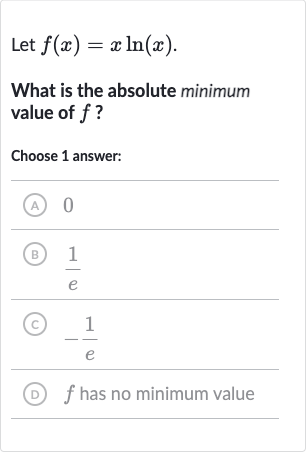Full solution
Q. Let .What is the absolute minimum value of ?Choose answer:(A) (B) (C) (D) has no minimum value
- Find Critical Points: To find the absolute minimum value of the function , we need to find the critical points of the function by taking the derivative and setting it equal to zero.
- Calculate Derivative: The derivative of with respect to is . Using the product rule for differentiation, we get:
- Set Derivative Equal to Zero: Now we set the derivative equal to zero to find the critical points: .
- Solve for x: To solve for x, we subtract from both sides:.
- Exponentiate Equation: To get by itself, we exponentiate both sides of the equation: .
- Determine Critical Point Type: Since is just , we have:
- Substitute into Function: Now we need to determine if this critical point is a minimum, maximum, or neither. We can do this by using the second derivative test or by analyzing the behavior of the first derivative around the critical point. Since the function is increasing for x > 0, and since the critical point is the only critical point, this suggests that has an absolute minimum at .
- Calculate Minimum Value: To find the minimum value of , we substitute into the original function:.
- Final Answer: We know that is the same as , which simplifies to because and . So, .
- Final Answer: We know that is the same as , which simplifies to because and . So, . Therefore, the absolute minimum value of the function is , which corresponds to answer choice .
More problems from Multiplication with rational exponents
QuestionGet tutor help
QuestionGet tutor help
QuestionGet tutor help
QuestionGet tutor help
QuestionGet tutor help
QuestionGet tutor help
QuestionGet tutor help
QuestionGet tutor help
QuestionGet tutor help

